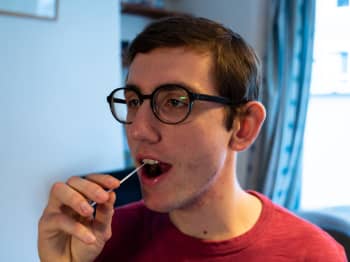First Spaceflight for
Gates Cambridge Scholar
On 10th November Kayla Barron blasted off into space on her first trip to the International Space Station where she is part of a six-month science mission.
Kayla, a Gates Cambridge alumna, was one of four astronauts on the SpaceX Crew Dragon.
Kayla’s trip is the third crew rotation mission with astronauts on the SpaceX Crew Dragon spacecraft and the fourth flight with astronauts as part of the agency’s Commercial Crew Programme.
The other astronauts are Raja Chari and Tom Marshburn from NASA, like Kayla, and Matthias Maurer from the European Space Agency.
Three of the four, including Kayla, are first-time flyers. Kayla was a mission specialist on the flight into space and worked closely with the commander and the pilot to monitor the spacecraft during the launch phase, as she will on the re-entry phase.
At the space station she is working as a flight engineer for Expedition 66 and has been researching how to manipulate nanoparticles for the InSPACE-4 space manufacturing study.
Earlier this month, Kayla completed a six and a half hour spacewalk to replace a malfunctioning communications antenna.
Kayla [2011] has an MPhil in nuclear engineering from the University of Cambridge where she met her husband, Tom Barron, who was also a Gates Cambridge Scholar.
After leaving Cambridge, she went on to serve in the US Navy, having done her undergraduate degree at the US Naval Academy. At the time of her selection as an astronaut candidate in 2017, she was serving as the flag aide to the superintendent of the US Naval Academy.
Kayla only applied to NASA as a result of a serendipitous meeting with an astronaut who told her about her mission to the International Space Station and the engineering challenges she faced. Through talking to the astronaut, Kayla realised that working on the space station was similar to working on a submarine.
“The chance to go to Cambridge allowed me to form friendships with people who grew up all around the world”
Kayla Barron
Kayla inside the ISS’s Destiny lab.
Kayla in her spacesuit during a training session at SpaceX headquarters.
Kayla checks out chili peppers growing inside the ISS’s Advanced Plant Habitat.
Kayla was one of 11 trainees chosen from 18,000 applicants to NASA’s Artemis programme. She says her fellow trainees all shared certain characteristics: an appetite for adventure and a passion for working in teams.
Her two-year training course, which finished in late 2019, involved learning a lot of new skills. For instance, she had to learn how to walk in zero gravity at a neutral buoyancy lab. This included underwater training to mimic buoyancy effects. She also had to do aviation training in a T38 jet – the world’s first supersonic trainer jet, learn robotics and ISS systems as well as study Russian.
Kayla has been a pioneer throughout her working life. One of the first class of women commissioned into the US Navy’s submarine community, she could, after her trip to the ISS, become one of the first women to set foot on the Moon.
Artemis will send astronauts to land and live on the Moon by 2024 and around once a year after that. In addition to exploring the Moon they will learn how to live and operate on the surface of another celestial body and test the technologies needed to send astronauts on missions to Mars.
Kayla recently told The Scholar magazine about her excitement at being chosen for the ISS mission: “The opportunity to live and work on one of the most incredible engineering marvels in the history of the world is just amazing to me.
“The space station, which is due to be decommissioned in 2024, has been up there for over 20 years with continuous human presence, doing amazing science and inspiring people, so the chance to be a part of that mission is really exciting.”
Kayla told the magazine that, when applying to be a Gates Cambridge Scholar, she had no idea how much influence the experience would have on her life.
“While being a Gates Cambridge Scholar is about pursuing a degree, whether studying or conducting research, a big part of the experience is also joining this global community and exploring opportunities at Cambridge,” she said.
“Coming from the somewhat cloistered environment of a U.S. military academy, the chance to go to Cambridge and be part of such a diverse community allowed me to form friendships with people who grew up all around the world and are passionate about things I had never even thought about before.
“Those friendships had a big influence on me in terms of how I interact with the world and my curiosity as a person.
“Also, Tom and I met during the Gates Cambridge orientation weekend, and the rest is sort of history. So I can credit the Gates community with finding my partner!”
Kayla Barron is pictured during her six and a half hour spacewalk to replace a failed antenna system on the International Space Station’s Port-1 truss structure.
All images courtesy of NASA and used under the Creative Commons license: Attribution-NonCommercial-NoDerivs.
source: www.cam.ac.uk




























